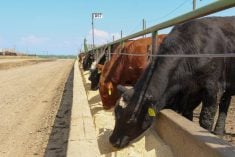As of mid-February, Alberta packers were buying fed cattle in a live basis in the range of $195-$196/cwt delivered, up $10/cwt from 30 days earlier. The market had been percolating higher due to tighter supplies of market-ready fed cattle. Dressed cattle marketing weights have been declining on both sides of the border, giving the feedlot operators the upper hand in negotiations.
There will be a sharp year-over-year decline in U.S. beef production in the second quarter of 2023. Beef demand continues to exceed expectations. Consumer spending has been resilient despite the elevated inflation and higher interest rates.
Deferred live cattle futures are trading near historical highs, which has supported feeder cattle prices. Yearling prices were up approximately $10/cwt from mid-January, while calves were trading $15/cwt above a month earlier. U.S. feeder cattle prices appear to be pushing the western Canadian market higher. South of the border, the markets are contending with the fourth consecutive year-over-year decline in the calf crop and the lowest beef cow numbers since 1962.
Read Also

Harvest wraps up and fall work begins
At the Eppich famly ranch in western Saskatchewan, the fall harvest was successful with few breakdowns, cows and calves have been sorted and a new tractor has arrived
U.S. and Canadian numbers
U.S. feeder cattle placements in feedlots with 1,000 head-plus capacity during the third quarter of 2022 were only down 38,000 head from the previous year. However, during the final quarter of 2022, U.S feeder cattle placements were 5.829 million head, down 347,000 head from the fourth quarter of 2021. U.S. beef production during the first two months of 2023 will be similar to last year. During March and April, U.S. monthly beef production will run 200 million pounds below year-ago levels. During June, U.S. beef production will be down approximately 100 million pounds from June 2022. In addition to lower cattle-on-feed numbers, carcass processing weights are running 1.5 per cent below last year.

In Alberta and Saskatchewan, feedlot placements during the final quarter of 2022 were similar to the fourth quarter of 2023. Basis levels in Alberta had improved over the past month and carcass weights were also coming down. The backlog of market-ready supplies is slowly reducing. Given the lower production south of the border, U.S. packers will be more aggressive for Canadian fed cattle in the second quarter of 2023, which will cause fed cattle basis levels to strengthen.
Consumer demand will taper off
Beef demand continues to exceed expectations. U.S. employers added 4.5 million jobs in 2022 and 517,00 jobs in January 2023. Canada added approximately 400,000 jobs in 2022 and 150,00 jobs in January 2023. Wages have been running four to five per cent above year-ago levels.
Consumer spending at restaurants has been running 12 per cent above a year ago, while spending at grocers has been up eight per cent. Beef demand will decrease due to lower disposable income. Secondly, we’ll see a change in behaviour or tastes. It takes about 12-18 months for interest rate hikes to work through the economy. Consumers will reign in food spending in the latter half of 2023. The economy has peaked will likely move into contraction in the latter half of 2023.
The Canadian and U.S. feeder cattle markets have been digesting the U.S. Jan. 1 Cattle Inventory Report. The number of U.S. beef cows that had calved as of Jan. 1 came in at 28.918 million, down 1.1 million head from Jan. 1 2022. Calves born in the U.S. during 2022 totalled 34.5 million head, down 700,00 head from 2021.
Given the lower calf and cow numbers in the U.S., the feeder cattle market will function to encourage production. The U.S. cow slaughter will decline, likely starting in the second quarter of 2023 and then more significantly in the third and fourth quarters. Heifer retention will start in the summer, barring adverse dry conditions in the U.S. Southern Plains. During the fall of 2023, there could be 300,000 to 400,000 heifers taken out of the feeder cattle pool for herd expansion. The U.S. feeder market will not only contend with a lower calf crop but supplies will be further reduced due to heifer retention.
Canadian feeder cattle exports to the U.S. increased sharply in 2014 and 2015. For western Canadian feeder cattle, there will be a strong pull from south of the border in the latter half of 2023. This increase in U.S. demand comes two years after a major drought and herd liquidation on the Prairies. Keep in mind that U.S. farmers are expected to plant an additional three to four million acres of corn. In Canada, barley supplies will once again be drained by Chinese demand, so Alberta feedlots will continue to use U.S. corn. There is a competitive disadvantage in Western Canada.
Fed cattle prices in Alberta are expected to reach a high of $215-$218/cwt in April and then soften to $212-215/cwt in the summer and fall. The outlook for the fall and winter is uncertain as the economy could contract. This contraction in the economy comes as the feeder market functions to expand. The feeder market is expected to make historical highs in August and September and then subside. Corn usually makes a seasonal low in September.
















